I love the poetry of Langston Hughes. I used to read poems from his book The Dream Keeper to my second grade students. I always shared poems from the book when I read them Coming Home: from the Life of Langston Hughes, a picture book biography that was written and illustrated by Floyd Cooper.
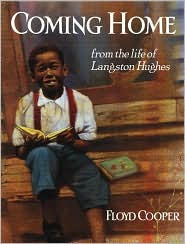
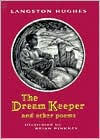
Today, I’m reviewing Tony Medina’s book of "autobiographical" poems about Langston Hughes entitled Love to Langston. As the front flap of the book jacket states: “Each poem explores an important event or theme in Hughes’ life, from his lonely childhood and the racism he overcame, to his love of travel and his ultimate success as a writer.” In his introduction, Medina tells readers that his book “captures glimpses of Langston’s life in the art form he cherished most—poetry.” The book's poems are narrated in the voice of Langston Hughes.
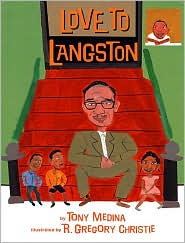
LOVE TO LANGSTON
Written by Tony Medina
Illustrated by R. Gregory Christie
Lee & Low, 2002
The fourteen poems contained in the book give us glimpses not only of events and themes in Hughes’ life—but also a peek inside the man, his thoughts and emotions. Because Medina speaks in the voice of Hughes, the poems seem personal. It's as if the poet is talking directly to and confiding in the book’s readers.
Following are excerpts from Love to Langston, which I hope will give you a flavor of Medina’s free verse poetry in the book:
Langston speaks of libraries being special places for him in his poem Libraries.
From Libraries
to sit and to stay
with books and books
and books of endless
beautiful words
keeping me company
taking my loneliness
and blues
away
He explains his feelings for his father in another poem:
From I Do Not Like My Father Much
My father is a man who could not do what
he wanted to do or be what he wanted to be
so he takes out his pain on everyone
even his own family
His anger causes me pain
just the same
No, I do not like my father much
He tells of his love for his favorite place in Harlem Is the Capital of My World:
Harlem is a bouquet of black roses
all packed together and protected
by blackness and pride…
Yeah, Harlem is where I be—
where I could be
Me
Harlem is the capital of my world
In Jazz Makes Me Sing, Langston relates how the music “makes me/think about my sadness/and how I ain’t alone/The blues makes me feel/a whole lot better/It hits my heart in/the funny bone.”
In Poetry Means the World to Me, he expresses the importance of poetry in his life.
From Poetry Means the World to Me
Poetry means the world to me
it’s how I laugh and sing
how I cry and ask why…
Poetry is what I use
To say
I love you
The fourteen “glimpses” into the life of Langston Hughes also: show us a young boy learning about his people from listening to the stories his grandma tells him; speak of the prejudice he faced in school and about Jim Crow; recall his high school days when he lived in a white neighborhood where his white friends were immigrants and outsiders like him; and tell about his travels to many different places around the world.
Medina modeled some of his poems in Love to Langston after poems Hughes wrote for The Dream Keeper: Grandma’s Stories evokes Aunt Sue’s Stories and Sometimes Life Ain’t Always a Hoot echoes the sentiments expressed in Mother to Son.
In the back matter, Medina includes Notes for Love to Langston. In these detailed notes, the author provides information about the poet’s life and background information for each of the poems. Love to Langston is an excellent book to share with students during Black History Month--or any time of the school year.
Classroom Connections
- Read Coming Home to your students along with a few poem selections from The Dream Keeper.
- Continue to read two or three poems a day from The Dream Keeper for a period of four or five days.
- Then share and discuss the fourteen poems in Love to Langston.
- Follow up your reading of Love to Langston with readings of selected poems from the book—along with the detailed notes about those particular poems.
- Read Grandma’s Stories and Aunt Sue’s Stories, Sometimes Life Ain’t Always a Hoot and Mother to Son. Discuss the poems with your students and talk about the similarities in Hughes’ and Medina’s poems.
- It would be great to have several paperback copies of The Dream Keeper in your classroom. Some of the poems in the book are short and would be easy for children to memorize. You could let children peruse the book and select poems they might like to memorize and recite for their classmates or share with them in a choral reading exercise.
Here are links to some poems written by Langston Hughes:
Dream Variations
Dreams
Harlem
I, Too
Mother to Son
The Negro Speaks of Rivers
Theme for English B
From Random House: More than twenty poems excerpted from Vintage Hughes
Click here to read about the career and poetry of Langston Hughes.
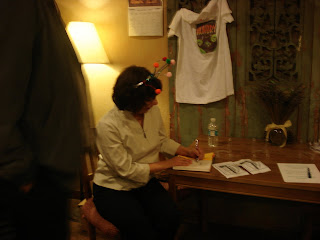 The moment finally came! Signing a copy of HUNGRY at Cobb Mountain's very own coffee shop and bookstore, The Bookkeeper. Bill made pistachio Home Worlder cookies, with five tentacles rather than six, but who's counting! Pipecleaner tentacles were made with googly eyes. There were green alien Italian sodas to drink and a t-shirt giveaway.
The moment finally came! Signing a copy of HUNGRY at Cobb Mountain's very own coffee shop and bookstore, The Bookkeeper. Bill made pistachio Home Worlder cookies, with five tentacles rather than six, but who's counting! Pipecleaner tentacles were made with googly eyes. There were green alien Italian sodas to drink and a t-shirt giveaway.
My good friend and writing partner, Mary, helped in my presentation as Commander Pggsbtk, (otherwise known as Deborah's grandmother Pig's Butt). Mary and I did a "spit and greet," and she ably assisted applying Pggsbtk's beauty secret to transform Tom, one of the Bookkeeper's visitor's, into an alien. There were wonderful screams of pain from the bathroom as the beauty secret did its job. Norm, Mary's husband, made a certificate for the kids that said they were officially part of the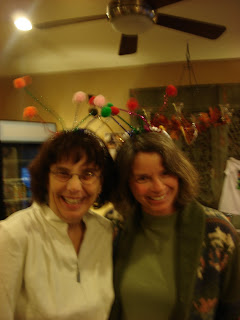 invasion force and were not to be eaten.
invasion force and were not to be eaten.
Since then Mary helped me at an assembly at school in which a sixth grader named Tristan outdid Tom with his screams from the back of the stage. He was very brave as he went out on his mission to terrorize Earthlings with his new alien face. One of the pleasures of all of this is being a teacher and a writer. The kids at school have been genuinely excited for me.
I signed books at Funtopia last weekend as a fund raiser for Minnie Cannon's sixth grade science camp. Over 200 dollars was raised!
My family, community, friends, collegues, and church (even Episcopalians can appreciate hungry aliens) have been so supportive. All I can say is a humble thank you to everyone who have made the last two weeks so memorable.
 I wish I could include my second graders in this picture, but I'm not sure if their parents would want their picture on the internet.
I wish I could include my second graders in this picture, but I'm not sure if their parents would want their picture on the internet.
By the way, that's Serjio's arm, and Starfall, the best reading site on the Internet on the monitor behind me. Everybody at school, every teacher, aide, and student signed the banner.
As a celebration, two teachers at my school decorated my room after I left late on October 1st. They ended up calling my husband to get me out of there.
On the morning of the 2nd, I wasn't really thinking about HUNGRY as much as I was feeling overwhelmed by teaching: the needs the kids have and the expectations put on schools. I'm working with a very bright 4th grade reading group who are below grade level for a variety of causes: reading disabilities, second languages, difficulty focusing, and, for a few, home issues.
I love this group. They're good thinkers and sweet kids, but they need me to go slow. They need repetition and lots and lots of practice on skills. I'm a believer in using data to inform instruction, and I'm not against standards. I just want the expectations to be reasonable. When I was in fourth grade, I didn't have to write a summary on bonsai (a release writing prompt for the 4th grade state writing test). My parents wouldn't have known bonsia from bubble gum. Thinking back on the type of 4th grader I was, I wonder if I could have easily describe the art of growing bonsai. I'm sure my lack of background knowledge would have reflected in my writing performance.
I'm not saying, don't teach kids how to write! But what this group needs more than anything else is to get a good solid understanding of SENTENCE construction, which we work on daily. I want them to write decent paragraphs by the end of 4th grade (which they are still shaky about the details-- like not starting each sentence on a new line), and if all of them succeed I'll be doing the happy teacher dance. But I'm concerned for March when they have to take the test, that as far as they'll come as writers may not be far enough.
So, October 2nd, I got to school feeling heavy and worried and grumpy. Gail Marshall said she needed something from my room and hung around as I dawdled getting my lunch into the refrigerator in the teachers' room and then spent more time running off work for later in the day. On the way across the quad to my room, we talked about how as a teacher one can work 24/7, and it's still wouldn't be enough to do everything. We talked about how it was only October and that we were already tired.
I unlocked my door and was met with a banner, flowers, balloons, and silly string. Oh, there was chocolate. Lots of it. Gail had come with me to see my reaction. I'm still smiling as I write this, almost two weeks later. The surprise went straight to my heart and burst open the dark crystal of frustration that had gotten lodged there. Thank you, Gail. (And Brandy, her partner in chocolate.)
Here are titles of some school stories I recommend:
GETTING THE JITTERS

Off to School, Baby Duck!
Written by Amy Hest
Illustrated by Jill Barton
Candlewick Press, 1999
Baby Duck is nervous about going to school. It’s a good thing Grampa is on hand to help allay Baby’s fears and send her into class singing a happy song.

Wemberly Worried
Written & illustrated by Kevin Henkes
Greenwillow/HaperCollins, 2000
FUN AT SCHOOL

Someone Says
Written by Carole Lexa Schaefer
Illustrated by Pierr Morgan
Viking, 2003
For children in nursery school through grade one. This book celebrates childhood creativity. The spare text and art work together perfectly in this joyful picture book about imaginative play.
A BAD DAY AT SCHOOL

Lilly’s Purple Plastic Purse
Written & illustrated by Kevin Henkes
Greenwillow/HaperCollins, 1996

Today Was a Terrible Day
Written by Patricia Reilly Giff
Illustrated by Susanna Natti
Viking, 1982
Ronald Morgan gets discouraged at school one day when he does everything wrong—including making mistakes when reading aloud in class. Then, on the way home, he reads the note his teacher has given him without any help. The day’s troubles dissipate in the excitement of knowing that he can actually read. (Pair this book with Alexander and the Terrible Horrible No Good Very Bad Day and have children discuss their “terrible” days.)
SCHOOL STORIES TO TICKLE YOUR FUNNY BONE

David Goes to School
Written & Illustrated by David Shannon
Blue Sky Press, 1999
 Morris the Moose Goes to School
Morris the Moose Goes to School
Written & illustrated by B. Wiseman
Harper & Row, 1970
Morris can’t read or count. He goes to school to learn how. Young children will enjoy all the funny situations and experiences Morris has during his first day in an elementary classroom.

Math Curse
Written by Jon Scieszka
Illustrated by lane Smith
Viking, 1995

Captain Abdul’s Pirate School
Written & illustrated by Colin McNaughton
Candlewick Press, 1996
This is a hilarious tale told via the diary of a young girl whose father has sent her off to pirate school to toughen her up. Children will laugh at some of the pirates’ names—Poop Deck Percy Ploppe, Walker the Plank, Yardarm Pitts—and will enjoy the ending in which the children attending the school outwit the pirates, take over the ship, become pirates themselves and decide not to return home. Ooh-arrgh!
A Fine, Fine School
Written by Sharon Creech
Illustrated by Harry Bliss
Scholastic, 2001
No matter how fine a school may be—too much of a good thing can prove to be a bad idea. Principal Keene learns about some of the other important things in children’s lives from a young girl who has the courage to speak up to an adult.
SCHOOL STORIES ABOUT TEASING AND BULLYING

Chrysanthemum
Written & illustrated by Kevin Henkes
Greenwillow, 1991
Hooway for Wodney Wat
Written by Helen Lester
Illustrated by Lyn Munsinger
Houghton Mifflin, 1999
Poor Wodney Wat (Rodney Rat) can’t pronounce his r’s. His classmates constantly tease him. When Camilla Capybara, a new student who is a big bully, enters the classroom, Wodney fears his days at school will only get worse. Fortunately for Wodney, he is a hero by story’s end because he gets rid of Camilla….forever.

Stand Tall, Molly Lou Mellon
Written by Patty Lovell
Illustrated by David Catrow
Penguin, 2001
Molly Lou is the shortest girl in first grade. She’s got buck teeth, has a terrible singing voice, and is quite clumsy. Her grandma gives her the courage to take pride in herself. Then Molly Lou moves to a new town away from her grandma and old friends. A bully picks on her and teases her—but Molly takes it all in stride and wins over her classmates…including her harasser.

Thank You, Mr. Falker
Written & illustrated by Patricia Polacco
Philomel, 1998
Autobiographical story about young Polacco who was teased by classmates and called a “dummy” because she couldn’t read. In fifth grade, a teacher who is both understanding and wise takes the time to tutor the young artist every day after school and opens the world of words to her.
GOING TO SCHOOL AT SEA
Sailing Home: A Story of a Childhood at Sea
Written by Gloria Rand
Illustrated by Ted Rand
NorthSouth, 2001
This story is based on the experiences of the children of Captain and Mrs. Mads Albert Madsen aboard the four-masted sailing bark named the
John Ena, a ship that carried cargo all over the world during the late 1800s and early 1900s. The children learn school lessons from their mother and governess. Their father teaches them about the planets, stars, celestial navigation, and how to send signals with flags at sea. The back matter of the book includes an afterward and Madsen family photographs.
Since my computer crashed early Monday morning, it looks like I'll have to write my post directly on blogger because the laptop I have available doesn't have any word processing program. Oh well, I think you may see some typos.
Recently,
I wrote reviews of two sea-themed books:
Into the A, B, Sea and
What the Sea Saw. I've got reviews of three more books about the sea. These are nonfiction picture books about tidepools.

IN ONE TIDEPOOL: CRABS, SNAILS AND SALTY TAILS
Written by Anthony D. Fredericks
Illustrated by Jennifer DiRubbio
Dawn Publications, 2002
Fredericks takes a non-typical approach with his nonfiction text. This book is a cumulative tale told in verse about a young girl observing the creatures in a tidepool: barnacles, fish, anemones, a blood-red sponge, crabs, snails, limpets, and a sea star. The names of all the creatures mentioned in the text are written in bold print throughout the book. This will be a help with word recognition--especially for children who are encountering these words for the first time.
Here is an excerpt to give you a flavor of the author's text:
Anemones with stinging cells
Hold fast to rocks and empty shells,
Friends to fish that dart and hide
And find their food in the surging tide,
Near barnacles with legs so small
That waved at the girl that watched them all.
In one tidepool, fun to explore,
A web of life on a rugged shore.
At the end of IN ONE TIDEPOOL, Fredericks includes a section called Field Notes, which contains information about the animals in the book. The author notes that all of the animals can be found on both coasts of North America--but that the specific species illustrated in the book live on the West Coast. He also provides a list of recommended books about seashore ecology. This is a good book for reading aloud to very young children to introduce them to the varied life that exists in tidepools.

AT HOME IN THE TIDE POOL
Written by Alexandra Wright
Illustrated by Marshall Peck III
Charlesbridge, 1992
AT HOME IN THE TIDE POOL is the most typical nonfiction book of the three revi

























Alethea...what fun! And how imaginative. The Heroine's Journey presentation you sent me is marvelous as well...good educational service as well as attractive.
I am thrilled the book signings have been such a positive experience.
Best,
Norm